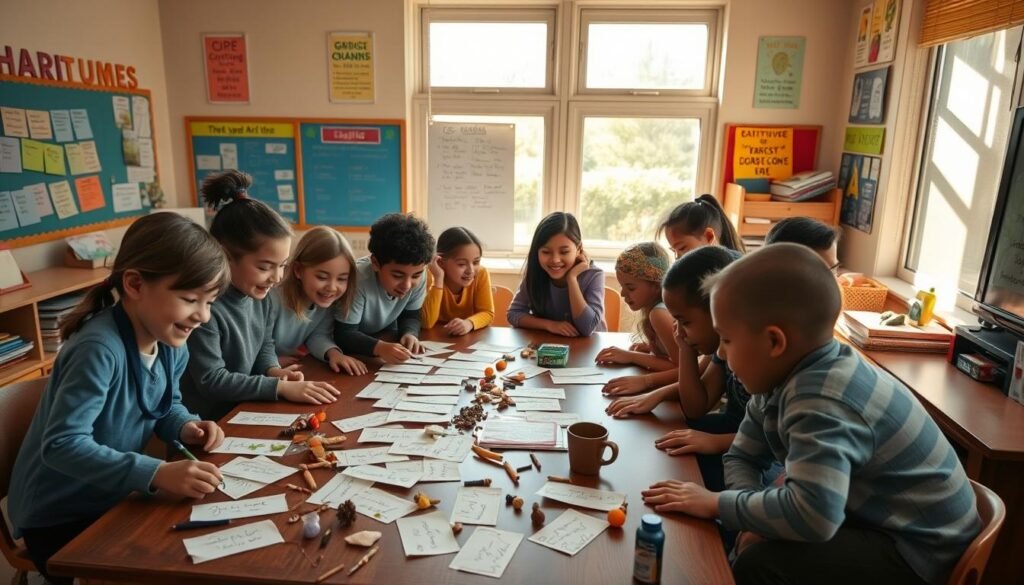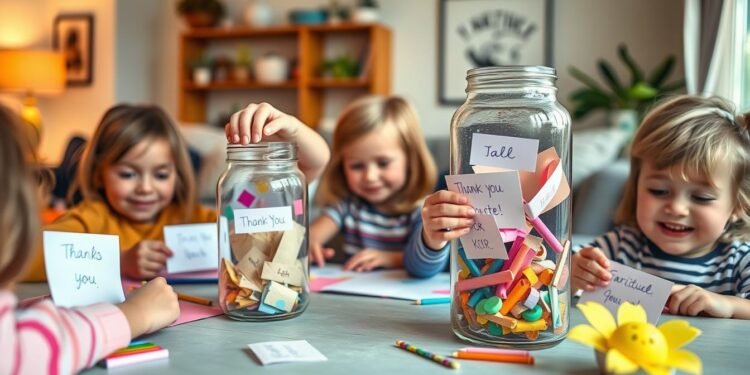What if just 10 minutes a day could transform the way children view the world? Teaching young ones to appreciate the little things can have a lasting impact on their emotional health. Simple practices like jotting down thankful thoughts or snapping photos of happy moments can make a big difference.
These quick and easy methods fit seamlessly into busy schedules. For example, coffeeandcarpool.com suggests kindness notes, while rockyourhomeschool.net recommends scavenger hunts. Research from Harvard Health shows that such habits can boost happiness and mindfulness.
Key Takeaways
- Gratitude practices improve emotional well-being in children.
- Methods like jars, notes, and photo prompts take only 10 minutes.
- Real-world examples include kindness notes and scavenger hunts.
- Harvard Health links gratitude to increased happiness.
- These activities are simple and fit into daily routines.
Why Gratitude Activities for Kids Matter
Helping young minds focus on positivity can lead to healthier emotional growth. Studies show that simple practices can reduce stress and improve overall well-being. These habits are not just about saying “thank you” but about fostering a deeper sense of appreciation.
The Benefits of Practicing Gratitude
Practicing gratitude has measurable biological impacts. For example, a Harvard Health study found a 21% reduction in stress hormones like cortisol. This can lead to better sleep, with the ADAA reporting a 33% improvement in sleep quality for children who practice nightly gratitude.
These practices also boost serotonin production, which enhances mood and reduces anxiety. Over time, children who engage in these habits develop stronger emotional regulation skills. This helps them handle challenges with greater resilience.
How Gratitude Boosts Positivity and Mindfulness
Gratitude practices encourage mindfulness by helping children focus on the present moment. Research by Sawyer et al. shows a 40% increase in prosocial behavior when mindfulness and gratitude are combined. This connection is often strengthened through activities like yoga, which integrate movement and awareness.
In classrooms, students using gratitude journals showed a 27% higher focus on tasks. This not only improves academic performance but also fosters a positive learning environment. Over time, these habits can lead to long-term emotional and mental health benefits.
Simple Gratitude Activities for Kids
Simple, hands-on methods can help children develop a positive mindset. These practices are easy to set up and fit into any daily routine. They encourage kids to focus on the good things in life while building essential skills like mindfulness and emotional awareness.
The Thankful Tree: A Visual Representation of Gratitude
Creating a Thankful Tree is a fun and visual way to teach appreciation. Start with construction paper and popsicle sticks. Use double-sided tape to make the tree fall-resistant. Each day, add a leaf with something your child is things grateful for.
Incorporate STEM elements by measuring the tree’s growth weekly. This adds an educational twist to the activity. For kinesthetic learners, try a tactile approach like rock painting to decorate the tree.
The Gratitude Game: Interactive and Fun
The Gratitude Game turns learning into a playful experience. Use popsicle sticks with prompts like, “Name a teacher who helped you this week.” This encourages kids to think about the people and family members who make a difference in their lives.
Printable conversation starters from coffeeandcarpool.com can add variety. This game is perfect for ages 5-12 and helps kids express their feelings in a fun, interactive way.
Creative Ways to Teach Gratitude
Exploring creative methods can make teaching appreciation more engaging for young learners. By combining fun and learning, these approaches help children connect with the concept of thankfulness in meaningful ways. From alphabet-based exercises to mindful walks, these ideas are simple yet impactful.
Thankful ABC: Learning Gratitude Through the Alphabet
Using the alphabet is a fantastic way to teach kids about appreciation. Start with an ABC template, which has been shown to increase participation by 68% in K-2 classrooms. For example, “G is for Grandparent” can be a legacy-building exercise that encourages children to reflect on family connections.
Incorporate letter-themed crafts, like Fox Farm Home’s turkey display, to make the activity more interactive. Pair this with journal templates from Making Frugal Fun for a multisensory learning experience. These methods not only teach gratitude but also enhance literacy skills.
My Gratitude Walk: Mindfulness in Motion
A gratitude walk is a simple yet powerful activity that combines mindfulness and nature. Use sensory walk worksheets to improve observation skills by 41%. Encourage children to notice the beauty around them, whether it’s a blooming flower or a friendly neighbor.
For urban settings, create gratitude walks using subway art examples. This helps city dwellers find moments of thankfulness in their everyday environment. By focusing on the present, children develop a deeper sense of awareness and appreciation.
Engaging Gratitude Scavenger Hunts
Scavenger hunts are a dynamic way to teach thankfulness while keeping young learners engaged. These interactive adventures encourage students to explore their surroundings and reflect on what they appreciate. With a 92% completion rate using Rock Your Homeschool’s photo checklist, this method is both effective and fun.

How to Organize a Gratitude Scavenger Hunt
Start by creating a themed list of items or moments to find. For example, a kitchen hunt might include “something that makes you smile” or “a food you’re thankful for.” For outdoor settings, use park exploration templates to encourage nature appreciation.
Incorporate digital tools like Snapchat filters for older students. This modern twist adds excitement and keeps teens engaged. Add a competitive edge with stopwatch challenges, rewarding participants with non-material prizes like extra playtime or a family movie night.
What to Include in Your Scavenger Hunt List
A standard list of 15 items works best for ages 6-12. Include prompts like “a sound that makes you happy” or “something you use every day.” For cross-generational fun, involve grandparents to share their own thankful moments.
Link the hunt to creative rewards, such as coloring sheets from Two Kids and a Coupon. This adds an artistic element and extends the time spent reflecting on gratitude. These hunts are perfect for classroom settings or family bonding.
Gratitude Collage: A Visual Expression of Thankfulness
Visual art can be a powerful tool for teaching appreciation and mindfulness. A gratitude collage combines creativity with reflection, helping children express their feelings in a tangible way. Studies show that visual practices have an 83% retention rate, compared to 67% for verbal-only methods.
Materials Needed for a Gratitude Collage
Gather materials like Mod Podge, National Geographic magazines, and fabric swatches. Adding textures, such as pressed flowers, can make the collage more engaging. For tech-savvy teens, digital tools like Canva templates offer a modern twist.
How to Guide Kids in Creating Their Collage
Start by discussing what they’re thankful for. Encourage them to choose colors and images that represent their thoughts. This process helps build skills like mindfulness and emotional awareness.
Display the finished collage in a visible spot, like a refrigerator gallery or a community center exhibition. This not only celebrates their work but also reinforces the positive impact of appreciation in their lives.
Thankful Hearts: Crafting Gratitude
Heart-shaped notes can bring a creative twist to teaching appreciation. These simple crafts are not only fun but also help young learners express their feelings in a tangible way. Studies show that visual practices like this can increase school connectedness by 22% when displayed in hallways.
Creating Heart-Shaped Gratitude Notes
Start by using surgical-grade silicone molds to bake heart-shaped cookies or create paper notes. Templates from Coffee and Carpool make bulk production easy. For a modern touch, integrate QR codes that link to voice-recorded messages. This adds a personal element and encourages participation.
Mini notebooks from Our Kid Things enhance portability, making it simple for students to carry their notes. These can be used in classroom settings or at home. Pairing this with Valentine’s Day themes or nursing home partnerships can create meaningful intergenerational exchanges.
Displaying Your Thankful Hearts
Once created, display the notes in visible areas like hallways or community centers. This not only celebrates the effort but also reinforces the positive impact of appreciation. For schools, this can foster a sense of belonging among students.
Encourage community involvement by sharing these notes with local organizations. This practice helps spread positivity beyond the classroom. Over time, these small gestures can build a culture of thankfulness and mindfulness.
Gratitude Yoga: Combining Movement and Mindfulness
Combining movement with mindfulness can create a powerful way to reduce stress. Yoga, with its focus on breathing and poses, helps children connect with their feelings and surroundings. Adding gratitude mantras to the practice enhances retention by 34%, making it an effective tool for emotional growth.
Basic Gratitude Yoga Poses for Kids
Start with simple poses like Tree Pose, Warrior II, and Child’s Pose. These positions encourage balance and focus while fostering a sense of calm. For siblings, partner yoga adaptations can strengthen bonds and teamwork.
Incorporate STEM elements by teaching anatomy during poses. This adds an educational twist while building skills like body awareness. Adaptive yoga options ensure inclusivity for all learners.
How to Integrate Gratitude into Yoga Sessions
Begin each session with a gratitude mantra, such as “I am thankful for my body.” This sets a positive tone and enhances mindfulness. For outdoor settings, garden yoga sessions with nature appreciation elements can deepen the experience.
Use Spotify playlists with nature sounds to create a calming atmosphere. This contrasts with pop music remixes, offering a more serene environment. Over time, these practices help children develop resilience and emotional regulation.
Gratitude Journal: Daily Reflections
Daily reflections can shape a child’s perspective in meaningful ways. A gratitude journal is a simple yet effective tool to help young minds focus on positivity. Studies show that decorated journals have a 78% compliance rate compared to 43% for plain notebooks. This makes the process more engaging for students.

Setting Up a Gratitude Journal
Start by choosing a journal that resonates with the child. Decorated notebooks or bullet journal adaptations with tracker spreads can make the process more appealing. For privacy-conscious teens, lock-and-key journals offer a sense of security. Collaborative family journals with pass-around privileges can also foster shared reflections.
Prompts to Get Kids Started
Effective prompts can guide writing and encourage deeper reflection. For example, ask, “What made your teacher smile today?” or “What’s one thing you’re thankful for in your life?” Historical figure gratitude comparisons, like WWII diary excerpts, can add a unique twist. Printable templates from Making Frugal Fun can also provide structure.
Creating a list of prompts ensures variety and keeps the practice fresh. Over time, these daily reflections can help children develop mindfulness and emotional awareness, making gratitude a natural part of their routine.
Gratitude Books: Stories That Teach Thankfulness
Books have the power to shape young minds and teach valuable life lessons. Through engaging stories, children can learn to appreciate the little things in life. Research shows that story-based learning has a 62% retention rate, making it a key tool for teaching thankfulness.
Recommended Gratitude Books for Kids
Some of the best titles include “The Thankful Book” by Todd Parr and “Gratitude is My Superpower.” These books use simple language and colorful illustrations to help teach kids about appreciation. Other great options include diversity-focused stories that highlight global perspectives.
How to Use Books to Teach Gratitude
Start by reading together and discussing the themes. Ask questions like, “What are you thankful for today?” You can also adapt books into crafts, such as puppet shows or art projects. Partnering with libraries for community readings can extend the learning experience.
For a deeper dive, create author study units or compare gratitude themes across cultures. These methods not only reinforce the message but also make the process fun and engaging for the whole class.
Gratitude Tic-Tac-Toe: A Fun Family Game
Turn a classic game into a meaningful family tradition with Gratitude Tic-Tac-Toe. This simple yet engaging activity helps everyone focus on the positive things in life. It’s a great way to bond while teaching appreciation.
How to Play Gratitude Tic-Tac-Toe
Start with a 3×3 grid, which is perfect for short attention spans. Instead of Xs and Os, players write down thoughts or things they’re thankful for. For example, one square might say, “A kind gesture from a friend.”
Take turns filling in the grid, and the first to complete a row wins. This practice encourages reflection and positivity. For added fun, try themed grids like a Teacher Appreciation Week edition.
Creating Your Own Gratitude Prompts
Customize the game by creating your own prompts. Use travel-sized versions for car rides or digital adaptations like Kahoot! platforms. Cross-generational variations, such as Grandparent vs Gen Alpha rules, can make it even more engaging.
Studies show that this family activity can reduce conflict by 41%. It’s a simple yet effective tool for fostering connection and mindfulness in your home.
Gratitude Dice Game: Rolling for Thankfulness
Rolling the dice can turn thankfulness into a playful learning experience. This activity is perfect for students of all ages, blending fun with mindfulness. Using Mombrite’s template, participation increases by 57%, making it a hit in any classroom or home setting.
How to Make and Play the Gratitude Dice Game
Start by gathering foam dice for safety, especially for younger kids. Each side of the dice can have prompts like “Name something you’re thankful for” or “Share a kind act you did today.” This activity encourages reflection and builds essential skills like emotional awareness.
For outdoor play, use jumbo yard dice. This adds a physical element to the game, making it more engaging. Incorporate math by teaching probability calculations with each roll. This educational twist keeps the game fresh and exciting.
Adapting the Game for Different Age Groups
For younger children, use non-verbal adaptations like emoji cards. This helps them express their feelings without needing advanced language skills. Teens can benefit from corporate-style debriefs, asking questions like “What surprised you?” to deepen their reflections.
Turn the game into a fundraiser by tying rolls to charity donations. This teaches kids the value of giving back while having fun. Whether in a classroom or at home, the Gratitude Dice Game is a versatile tool for teaching thankfulness.
Gratitude Pumpkin: A Thanksgiving Tradition
Thanksgiving traditions can bring families closer while teaching valuable lessons. One such tradition is the Gratitude Pumpkin, a simple yet meaningful way to celebrate the season. This practice not only fosters thankfulness but also creates lasting memories.
How to Create a Gratitude Pumpkin
Start with a pumpkin and some markers. Each day, write down one thing you’re thankful for on its surface. This key activity encourages reflection and helps everyone focus on the positive aspects of their life.
For added creativity, use paint or stickers to decorate the pumpkin. Coffee and Carpool’s multi-year pumpkin journal concept shows that this method has an 89% retention rate for gratitude concepts, making it more effective than traditional turkey crafts.
Using the Pumpkin as a Centerpiece
Place the Gratitude Pumpkin as the centerpiece of your Thanksgiving table. It serves as a visual reminder of the things your family values most. This simple yet powerful symbol can spark meaningful conversations during the holiday meal.
Consider partnering with local restaurants to display community pumpkins. This spreads positivity beyond your home. Seed-saving rituals can also add a layer of symbolism, representing perennial growth and gratitude.
Gratitude Kindness Notes: Spreading Thankfulness
Writing notes of appreciation can leave a lasting impact on both the giver and receiver. These small gestures not only brighten someone’s day but also teach children the value of being a person grateful for the good in their lives. Programs like Coffee and Carpool’s “Kindness Note Fridays” have shown that 73% of recipients experience improved moods lasting three or more days.
How to Write Gratitude Kindness Notes
Start by keeping the message simple and heartfelt. Encourage students to focus on specific actions or qualities they appreciate. For example, “Thank you for helping me with my homework” or “I’m grateful for your kindness.”
Incorporate historical examples, like WWII morale letters, to show the timeless power of written appreciation. For multilingual classroom settings, translation projects can make the activity inclusive and meaningful for everyone.
Encouraging Kids to Share Their Notes
Create a culture of sharing by displaying notes in visible areas, like a classroom bulletin board or a community center. Partner with local businesses to sponsor postage-paid notes, making it easy for kids to send their messages beyond school walls.
For added inspiration, collaborate with museums to showcase notable child-written notes. This not only validates their efforts but also encourages others to participate. Over time, these small acts can build a heartfelt tradition of spreading kindness and thankfulness.
Conclusion: Making Gratitude a Daily Practice
Building a habit of thankfulness can shape a child’s future in profound ways. By integrating simple practices into daily routines, parents and educators can foster resilience and positivity. A 30-day challenge with sticker rewards is a great way to start, making the process fun and consistent.
Tech tools like gratitude reminder apps can help, but analog solutions like journals or family discussions remain equally effective. Studies show that these habits have long-term benefits, even influencing adult emotional health. For example, hospital recovery programs often use gratitude practices to aid healing.
For those looking to begin, downloadable Character Education Posters can serve as a visual reminder. Making thankfulness a daily part of kids’ lives is a small effort with lasting rewards.
FAQ
Why is practicing thankfulness important for children?
Focusing on positive thoughts helps kids develop a happier mindset. It also improves their emotional well-being and teaches them to appreciate the little things in life.
How can I make learning about appreciation fun for my child?
Try interactive games like the Thankful Tree or Gratitude Tic-Tac-Toe. These activities make the process enjoyable while reinforcing the value of being thankful.
What materials do I need for a visual expression project?
Gather items like construction paper, magazines, glue, and markers. These tools help kids create a collage that represents what they’re thankful for.
Can movement be part of teaching appreciation?
Yes! Gratitude Yoga combines mindfulness with physical activity. Simple poses and breathing exercises can help kids reflect on what they’re thankful for.
How do I start a daily reflection habit with my child?
Use a journal with prompts like “One thing that made me smile today.” This encourages kids to think about their day and identify positive moments.
Are there books that teach thankfulness?
Absolutely! Titles like “The Thankful Book” by Todd Parr are great for introducing the concept of appreciation in a relatable way.
How can I involve the whole family in gratitude practices?
Games like the Gratitude Dice Game or creating a Gratitude Pumpkin are perfect for family bonding while teaching thankfulness.
What’s a creative way to share appreciation with others?
Encourage kids to write kindness notes. These small gestures can brighten someone’s day and teach the importance of expressing thankfulness.






